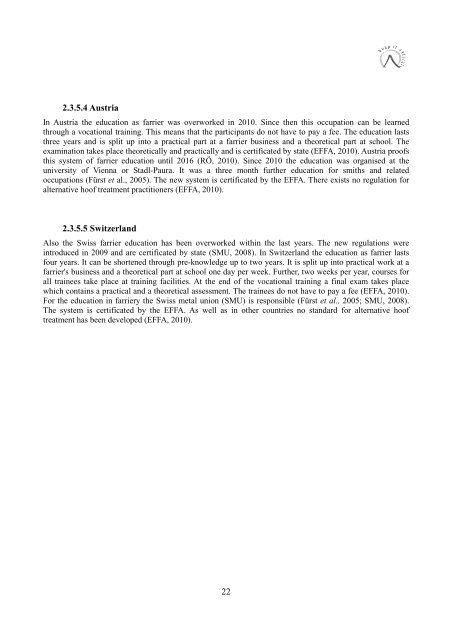Bachelor Thesis - Christina Kuenen - Hufpfleger
Bachelor Thesis - Christina Kuenen - Hufpfleger
Bachelor Thesis - Christina Kuenen - Hufpfleger
Create successful ePaper yourself
Turn your PDF publications into a flip-book with our unique Google optimized e-Paper software.
2.3.5.4 Austria<br />
In Austria the education as farrier was overworked in 2010. Since then this occupation can be learned<br />
through a vocational training. This means that the participants do not have to pay a fee. The education lasts<br />
three years and is split up into a practical part at a farrier business and a theoretical part at school. The<br />
examination takes place theoretically and practically and is certificated by state (EFFA, 2010). Austria proofs<br />
this system of farrier education until 2016 (RÖ, 2010). Since 2010 the education was organised at the<br />
university of Vienna or Stadl-Paura. It was a three month further education for smiths and related<br />
occupations (Fürst et al., 2005). The new system is certificated by the EFFA. There exists no regulation for<br />
alternative hoof treatment practitioners (EFFA, 2010).<br />
2.3.5.5 Switzerland<br />
Also the Swiss farrier education has been overworked within the last years. The new regulations were<br />
introduced in 2009 and are certificated by state (SMU, 2008). In Switzerland the education as farrier lasts<br />
four years. It can be shortened through pre-knowledge up to two years. It is split up into practical work at a<br />
farrier's business and a theoretical part at school one day per week. Further, two weeks per year, courses for<br />
all trainees take place at training facilities. At the end of the vocational training a final exam takes place<br />
which contains a practical and a theoretical assessment. The trainees do not have to pay a fee (EFFA, 2010).<br />
For the education in farriery the Swiss metal union (SMU) is responsible (Fürst et al., 2005; SMU, 2008).<br />
The system is certificated by the EFFA. As well as in other countries no standard for alternative hoof<br />
treatment has been developed (EFFA, 2010).<br />
22


